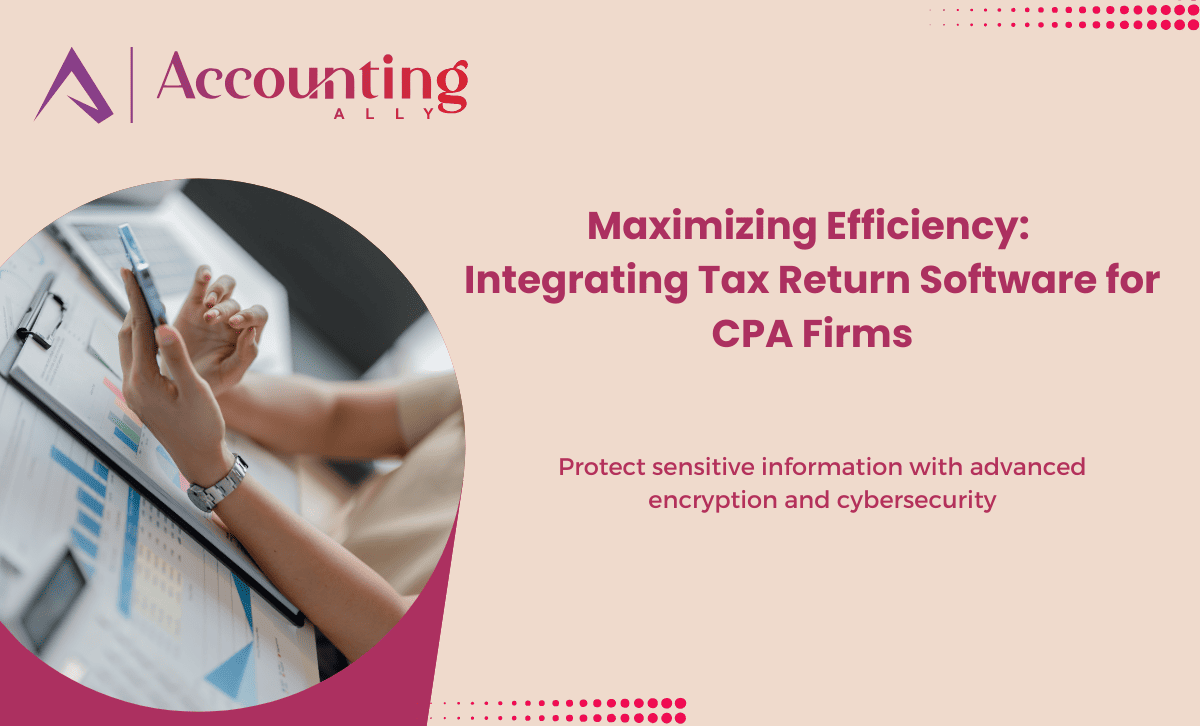Maximizing Efficiency: Integrating Tax Return Software for CPA Firms
As tax season nears, CPA firms are tasked with managing extensive data and intricate calculations with precision and efficiency. Integrating specialized tax return software offers a comprehensive solution, revolutionizing tax preparation through automation and advanced functionalities.
This not only streamlines processes but also greatly improves accuracy and compliance, safeguarding the firm’s reputation and strengthening client relationships.
Tax return software has become an essential tool for modern CPA firms. With the rise of outsourcing for CPA firms, these tools help streamline tax preparation and financial management.
Designed to navigate the complexities of tax laws and financial data, these tools feature capabilities tailored to the unique needs of accounting professionals.
High-performing tax return software minimizes human error and provides a platform for strategic financial planning and analysis. Automation of routine tasks allows CPAs to dedicate more time to complex, advisory-focused responsibilities.
Maximizing Efficiency and Compliance with Tax Return Tools
The advantages of incorporating tax return tools go beyond simplifying the filing process. They ensure ongoing compliance with evolving tax regulations, offer scalable solutions as the firm grows, and enhance client satisfaction through quicker and more reliable services.
Efficiency in tax filing improves dramatically, enabling firms to handle increased client volumes during peak seasons without sacrificing accuracy or quality.
However, successfully adopting new software involves more than selecting a feature-rich tool. Effective integration requires thorough planning, staff training, and continuous evaluation to align the technology with the firm’s operational workflows.
Addressing challenges like data migration, system compatibility, and user adoption is critical to unlocking the software’s full potential.
When implemented thoughtfully, these tools reduce risk and enhance service offerings, providing firms with a competitive edge.
Key Advantages and Best Practices for Implementing Tax Return Software
Choosing the Right Tax Software
Selecting the best tax return software involves carefully evaluating the firm’s needs alongside the software’s capabilities.
Considerations should include the client base size, complexity of tax cases, and essential features like multi-state return support, system integration ease, and cloud functionality.
High-performing software often includes audit support, amendment options, and direct filing capabilities, which can ease the workload during tax season.
Aligning software features with firm needs ensures a seamless transition and optimized workflows.
Comprehensive Employee Training
After selecting the appropriate software, prioritizing employee training is crucial. Comprehensive training ensures staff can fully utilize the software’s features.
Training should encompass basic operations, advanced functionalities, and troubleshooting, supplemented by regular updates covering new software features or tax law changes.
Ongoing education sustains a high skill level across the firm and ensures the software enhances productivity rather than hindering it.
Efficient Data Management
Integrating tax software often necessitates transferring existing client data into the new system. This process must be carefully managed to avoid data loss or inaccuracies. Best practices include cleaning data before migration, validating transferred data, and implementing secure, automated backups.
Effective data management improves tax filing reliability and allows firms to use historical data for analytics and strategic decision-making.
Strengthening Compliance and Security
Modern tax software is designed with compliance and security as priorities. Regular updates keep the software aligned with current tax regulations, and built-in tools assist firms in managing compliance efficiently, such as automated reminders for deadlines.
Advanced security measures like encryption and multi-factor authentication protect sensitive client data, addressing the growing risks of cybersecurity threats.
Continuous Evaluation and Improvement
To maximize the benefits of tax return software, firms should embrace a cycle of continuous improvement. This includes regularly assessing the software’s impact, gathering user feedback, and making necessary workflow adjustments.
Whether upgrading systems as the firm grows or refining workflows to better integrate with the software, ongoing optimization ensures sustained value from the investment.
By carefully selecting software, thoroughly training staff, managing data effectively, ensuring compliance, and continually evaluating performance, CPA firms can transform their tax preparation processes. This strategic approach minimizes errors, boosts efficiency, and elevates client satisfaction and the firm’s reputation.
Booming Tax Tech & FAO: The Future of Accounting
The tax preparation software market is experiencing significant growth. In 2024, the market was valued at approximately USD 80.89 billion and is projected to reach USD 192.56 billion by 2032, growing at a compound annual growth rate (CAGR) of 11.45% during this period. (Source)
Similarly, the finance and accounting outsourcing (FAO) sector is expanding. In 2024, the FAO market demonstrated robust growth of around 10% and is forecasted to maintain a double-digit growth rate of 10-12% through 2026. (Source)
These trends underscore the increasing reliance on advanced software solutions and outsourced services within the accounting industry, highlighting the importance of adopting these tools and strategies to remain competitive.
Conclusions : Effectively integrating tax return software empowers CPA firms to navigate tax season with greater accuracy and efficiency. Automation enhances compliance with tax laws and frees up time for strategic advisory services. Pairing tax software with outsourced bookkeeping services and outsourcing accounting services from Accounting Ally creates a complete solution, driving firm growth while ensuring accuracy and compliance.
(FAQ): Tax Returning Software
What is tax return software, and how does it benefit CPA firms?
Tax return software is a specialized tool designed to automate and streamline tax preparation, ensuring compliance and accuracy. It helps CPA firms reduce human errors, improve efficiency, and manage large volumes of tax filings with ease.
How does outsourcing accounting services complement tax return software?
Outsourcing accounting services allows firms to delegate routine bookkeeping and financial management tasks, ensuring that financial records are well-organized. This complements tax return software by providing accurate data inputs, leading to smoother tax preparation processes.
What are the key features to look for in tax return software?
Essential features include multi-state return support, audit assistance, cloud-based access, data security measures, direct e-filing capabilities, and integration with bookkeeping services.
How can firms ensure successful implementation of tax return software?
Successful implementation requires careful planning, employee training, data migration strategies, and ongoing software evaluations to ensure it aligns with the firm’s workflow.
Is tax return software secure?
Yes, modern tax return software includes advanced security measures like encryption, multi-factor authentication, and compliance updates to protect sensitive client data from cyber threats.


